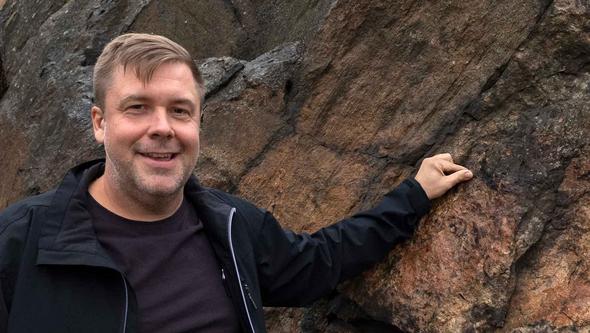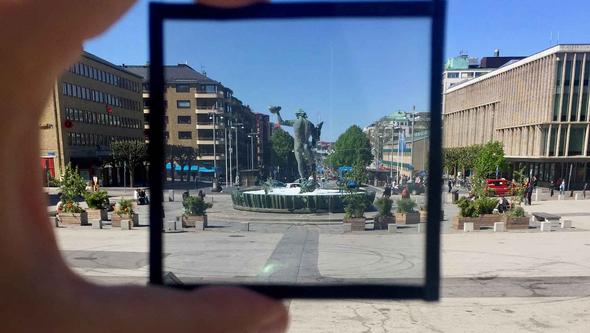
- Home
- Research
- Find research
- Bedrock as a battery
Bedrock as a battery
There is actually no shortage of energy on our planet. To solve our current energy problems however, we need to find new ways of capturing and storing energy. There are several ongoing research projects at the University of Gothenburg aimed at doing this.
When the sun shines or the wind blows, Sweden has excellent access to cheap energy. Prices for wind power and solar systems have fallen drastically and these energy solutions are growing rapidly. However, this is hardly any consolation on cold, windless days in December, as electricity prices break new records. About 50 per cent of Sweden’s energy consumption is used for heating and cooling. Homes and offices need to be warmed up, while industries require heating for various processes.
“Our planet has a hot interior, which is an interesting source of energy, primarily for heating. Geothermal energy is virtually independent of the seasons and in many parts of the world, there is great potential for utilising the heat from the Earth’s interior. Iceland is a good example,” explains geologist Johan Hogmalm.
GEOTHERMAL HEATING HAS become a popular solution. Water is heated in boreholes, which, with the help of heat pumps, is used to provide heating and hot water to households. However, the temperature difference in boreholes in Sweden is relatively small, which means that the heat pump requires a lot of electrical energy to raise the temperature of the returning water.

“We live in the world’s worst location for extracting energy from the Earth’s crust. You have to drill a very long way down to reach any considerably warmer layers of rock,” Johan Hogmalm explains.
An experiment was conducted in Finland, where two boreholes were drilled to a depth of more than six kilometres. The temperature at that depth is about 110°C. The idea was to pump water down into one of the boreholes, which would infiltrate the rock and reach the second hole, from which the heated water would be returned. However, there were so few cracks in the granite that the water had to be highly pressurised. Consequently, so much energy was used that it ate up any heating gains. Furthermore, there is a risk of highly pressurised water triggering earthquakes, which has happened in several other projects.
THE DENSE AND STABLE BEDROCK in Sweden, north of Hallandsås, the horst (a raised fault block bounded by normal faults) between the counties of Skåne and Halland, may nevertheless be part of the solution to the energy problem. As a battery.
“With wind power, a great deal of energy is produced within a limited time. So we have to be able to store the surplus,” explains Johan Hogmalm, who has a patented solution for heating up the bedrock when there is a surplus of cheap energy and subsequently extracting the heat when needed and the price is high.
In borehole layers, hot water is allowed to circulate in the rock, which heats it up. However, due to the use of plastic hoses, the water can only be heated to 90 degrees, which limits the applications of such forms of heat storage.
Hogmalm proposes using steel pipes and replacing the water with a different liquid that can be heated to several hundred degrees without evaporating. By placing a type of immersion heater inside the steel pipes, cheap surplus electricity from windy and sunny days can be immediately utilised to heat the rock.
“Once it has been heated, granite has properties that allow it to retain the heat for a long time. The heat can be stored for up to 12 months,” Hogmalm explains.
HOGMALM ENVISIONS LOCAL ‘BEDROCK BATTERIES’ in close proximity to homes or industries requiring heating. In contrast to hydrogen energy storage of the surplus energy, no sizeable installations are required on the surface.
“A typical thermal layer in the rock would be 50 to 100 metres in diameter, with 100 to 1,000 boreholes drilled to a depth of 250 metres. Such a bundle of boreholes would generate a ‘cluster effect’, where the holes in the middle of the layer would retain the heat best, and radiate it outwards to the edges.
If it works so well, why haven’t any thermal layers been installed in the bedrock yet?
It’s about money. It takes time to raise the SEK 50 to 100 million needed to start things up. But even with that initial cost, it’s the cheapest energy storage method I know of. And if such facilities could be built on an industrial scale, it would bring the cost down considerably,” Hogmalm explains.
THE HEATING OF HOMES and other premises in our cold climate is driving our need for smart heating solutions. Therefore, reducing the need for heating is also part of the solution to our energy problem.
For much of the year, heat leaks from the windows of a house. Physicist Alexandre Dmitriev is part of a group of researchers who have developed a solution for turning windowpanes into solar thermal collectors and can be up to ten degrees warmer on the inside. The trick is millions of solar antennae built with nanotechnology – nanoplasmonic antennae.
“An ordinary windowpane lets about 85 per cent of the sun’s energy through. In this project, we are trying to work on the remaining 15 per cent’, Alexandre Dmitriev explains.

Every radio, mobile phone, television or satellite uses antennae to capture the waves of broadcast information. Sunlight consists of electromagnetic waves that can also be collected by antennae. In Dmitriev’s project, the antennae are built to approximately the same dimensions as those of sunlight waves: 400–700 nanometres.
“Using the laws of physics, we can build the antenna structure we want so that the electrons inside the antennae are actively excited by the sunlight. The antennae for capturing the sun’s rays resemble round dimples on the surface, which we can use to orient the electrons so that they convert solar energy into heat in the most efficient way,” Dmitriev explains.
The challenge is to create a solar thermal collector surface that is transparent and thus can be used for windows on a large scale.
“Many windows, particularly those in office buildings, are already tinted and, with this technology, we can reduce the energy loss via the windows in a room by 50 per cent, thereby reducing the heating requirement by 20 per cent. There are considerable financial incentives in this technology. To date, we have designed a one square decimetre glass pane filled with these antennae, which is perceived as a transparent pane of glass.
THERE ARE ALSO PLANS to take the technology further, to enable it to cool the indoor air during the summer. With a small electronic bias , the antennae can take on a new function and reflect thermal sunlight waves instead of absorbing them, creating a cooling effect.
“We get an enormous amount of energy from the sun. We don’t need more energy – we just need to invent ways of making the most of it,” Dmitriev explains.
By: Olof Lönnehed
Energy storage
Energy storage is about storing produced energy so that it can be used later. This means that energy can be produced regardless of when it is used.
A simple example is solar energy. It is produced in large quantities during the summer, but there is a much greater need for heating and electricity for lighting in the winter. But energy storage can also be important at shorter intervals, such as between day and night, or from one minute to the next when particularly energy-demanding processes are happening.
The most common form of energy storage is the batteries that we all use in our mobile phones and cars, for example. A hydropower plant dam filling with water after rain is also a form of energy storage.
THREE VOICES ON...
..the main energy sources of the future and what the biggest challenges in the energy area are

Rickard Nygren, architect at White Arkitekter
In the future, the main energy sources will be renewable and fossil-free, such as geothermal heating, solar energy, etc. Wind power and solar energy for electricity, as well as biogas, are also important. In buildings of the future, solar systems will be very central. They can cover the basic requirement so that there is no complete loss of power during a crisis situation.
The greatest challenges are going to be to rebuild systems that are collectively owned by the community. And that it’s difficult to implement long-term solutions that may require large investments at the outset, but which are inexpensive in the long term. This is also true for owners of single-family dwellings, or owners of larger properties, who want solar panels installed on their buildings.
Another challenge is not to have advanced technologies based on supply chains with irreplaceable links in order to ensure that their manufacture and systems can be maintained in times of international crises, for example.
Eric Zinn, Sustainability Manager at Gothenburg Energi
The primary energy source in the future will be the Sun. Solar power prices are plummeting all over the world and it will dominate electricity production in the future. Those of us who live in latitudes with a bit less sunlight will rely more on wind and to some extent, bioenergy.
One of the biggest challenges is social sustainability. The massive expansion of new electricity production and power transmission imposes considerable demands on local communities in terms of acceptance and inclusion. Electrification and energy storage also entail a substantial need to extract various rare-earth metals, which are unevenly distributed among the countries of the world, which could lead to new geopolitical tensions. Another major challenge is lack of expertise – entirely new courses and study programmes need to be filled with young people who are yet to take an interest in these very interesting issues. Ultimately however, the pace of progress is the biggest challenge, because the climate threat is so acute that we must reduce carbon emissions faster than we have succeeded in doing so far.
Catarina Naucler, Innovation project team, Fortum
The investments in new fossil-free production that lie ahead will mainly be in existing technologies that can be scaled up relatively easily – wind power, nuclear power and solar power. Recent innovations tend to use business models and technology that enhance the solutions’ circularity aspects, resource efficiency and the phase-out of fossil fuels from industrial processes and transport.
The challenge is to satisfy a rapidly growing need to energy with sustainable solutions. A transparent and broad-based research-and-development agenda is needed – one which can focus not only on the development of individual types of power, but also adopt a systems perspective to ensure that the capabilities required are in place. In parallel, we also need to pay more attention to improving efficiency – in terms of energy consumption and the capacity to utilise the residual current from various sources.